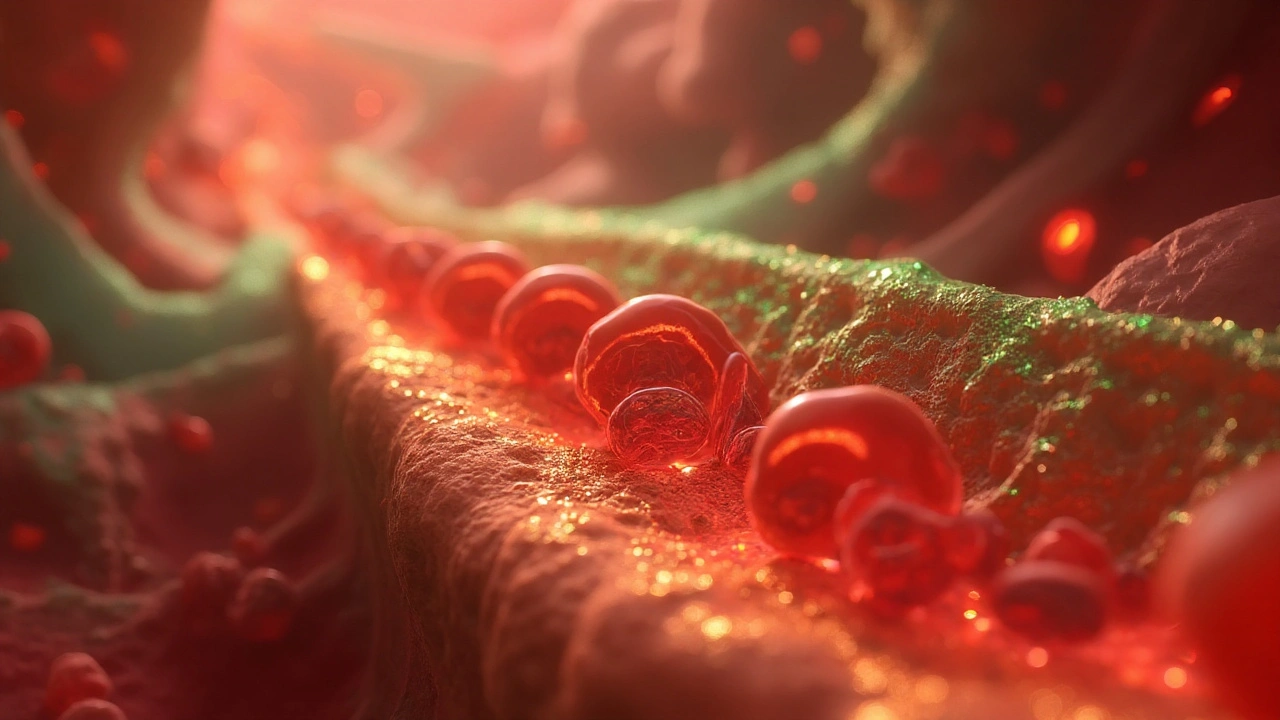Your bone marrow makes roughly two million new red blood cells every second. Miss one key vitamin, and that assembly line slows to a crawl. That vitamin is folate (vitamin B9). If you clicked this because you want the plain-English version-what folate actually does for red blood cells, how to spot a problem, and how to fix it with food and smart supplementation-you’re in the right place. I’ll keep it practical, with Australia in mind. As someone who does the weekly shop in Perth (usually with a German Shepherd named Bosco eyeing the butcher’s counter and a tabby cat, Olive, plotting dinner), I’ll show you what to buy, how much you need, and when to talk to your GP.
TL;DR: Folate’s role in red blood cell production
- Folate powers DNA building inside bone marrow. Without it, red cell precursors grow big but divide poorly-classic megaloblastic anemia.
- Daily targets (Adults): ~400 mcg DFE/day; pregnancy: ~600 mcg DFE; breastfeeding: ~500 mcg DFE. “DFE” accounts for folate from both foods and folic acid.
- Top sources: leafy greens, legumes, asparagus, avocado, citrus, and fortified breads/cereals. In Australia, wheat flour for bread-making is fortified with folic acid.
- Supplements: 400 mcg folic acid if diet’s short; pregnancy planning usually 400 mcg/day from ≥1 month before conception. High-risk pregnancies often need 4-5 mg/day under medical advice.
- Don’t mega-dose blindly: high folic acid can mask B12 deficiency. If you’re tired, pale, or have tingling, get B12 checked before cranking up folate.
How folate builds red blood cells (the science, made simple)
Red blood cells (RBCs) carry oxygen. They’re made in your bone marrow from stem cells that rapidly divide and mature into hemoglobin-packed discs. To pull that off, marrow cells must copy DNA fast and accurately. That’s where folate shines: it donates one-carbon units to build DNA bases (thymidine and purines) and supports methylation reactions that keep cell division on schedule.
Here’s the plain-English flow:
- In food, folate shows up as natural folates; in supplements and fortified foods, it’s folic acid. Your gut absorbs these and converts them into active forms inside cells.
- Inside the folate cycle, the active forms help make thymidine (dTMP) from dUMP and contribute to purine rings-core pieces of DNA. No folate, no clean DNA synthesis.
- Folate also teams with vitamin B12 to recycle homocysteine into methionine. That indirectly fuels methylation-the tiny on/off tags that guide cell functions.
- With enough iron, B12, folate, and erythropoietin, marrow cells divide, mature, and spit out millions of reticulocytes (young RBCs) each second.
What goes wrong when folate is low? DNA assembly stalls. The nucleus in red cell precursors lags while the cytoplasm keeps growing. Cells turn large and fragile-“megaloblastic.” You’ll see macrocytosis on a full blood count (MCV often >100 fL), a low reticulocyte count, and sometimes hypersegmented neutrophils on a blood film. Symptoms can include fatigue, breathlessness on effort, pale skin, a sore tongue, and sometimes irritability. Folate deficiency hits fast because your body stores are limited (a few months at best).
Folate doesn’t work alone. Iron provides the hemoglobin core for oxygen binding; B12 is key for the same DNA pathways and for nerve health. It’s common for clinicians to check all three-iron studies, B12, and folate-when macrocytosis or anemia shows up. Homocysteine rises in both B12 and folate deficiency, but methylmalonic acid rises mainly in B12 deficiency, which helps tell them apart.
Common reasons people run low on folate:
- Low intake: few greens/legumes, ultra-processed diet, heavy alcohol use.
- Higher needs: pregnancy, growth, hemolysis (faster RBC turnover).
- Malabsorption: untreated coeliac disease, inflammatory bowel disease, gastric surgery.
- Medications: methotrexate (antifolate), trimethoprim-sulfamethoxazole, some anti-seizure meds (phenytoin, valproate), sulfasalazine, hydroxyurea.
- Dialysis: losses during treatment.
Who says so? The mechanisms and clinical signs above are standard in hematology texts and reflected in guidance from the NIH Office of Dietary Supplements, Royal Australian College of General Practitioners (macrocytosis workup), and World Health Organization materials on megaloblastic anemia.

How to get enough folate-and use it safely
Daily targets are usually given as “DFE” (Dietary Folate Equivalents) because folic acid is absorbed better than food folate. The handy rule of thumb: 1 mcg DFE = 1 mcg food folate = 0.6 mcg folic acid with food (≈0.5 mcg on an empty stomach). Typical targets used by major health agencies:
- Adults: ~400 mcg DFE/day
- Pregnancy: ~600 mcg DFE/day
- Breastfeeding: ~500 mcg DFE/day
Australia-specific note: wheat flour for bread-making has been fortified with folic acid since 2009. That means standard sliced bread often contributes a useful chunk toward your daily needs, especially for people who don’t love vegetables. Still, food-first beats pill-first for most people.
Food sources that actually move the needle (typical folate per serve):
- Cooked lentils, 1/2 cup: ~180 mcg
- Cooked spinach, 1/2 cup: ~130 mcg
- Asparagus, 5 spears: ~100 mcg
- Avocado, 1 medium: ~110 mcg
- Chickpeas, 1/2 cup: ~140 mcg
- Fortified bread, 2 slices: ~80-200 mcg (varies by brand and slice size)
- Breakfast cereal (fortified), 1 serve: ~100-200 mcg
- Orange or mandarins: ~30-40 mcg
Quick win: a bean-and-spinach toastie covers a lot of ground. On a Sunday, I’ll grab a bunch of spinach and a can of chickpeas at the Subi farmers’ market, pile them on fortified grainy bread, and I’m most of the way to 400 mcg without trying.
Cooking tips that save folate:
- Go gentle on heat and water. Steam or sauté rather than boiling greens to death.
- If you do boil, use the liquid (soups, stews) so the folate you leached out still gets eaten.
- Eat some veg raw (salads) to hedge your bets.
When supplements make sense:
- You’re not hitting targets with food (shift work, travel, appetite issues).
- You’re planning pregnancy: most major guidelines suggest 400 mcg folic acid daily starting at least one month before conception and continuing through the first trimester.
- You’re in a higher-risk group for neural tube defects (previous NTD-affected pregnancy, certain anti-epileptic medicines, poorly controlled diabetes, malabsorption). In these cases, doctors often prescribe 4-5 mg folic acid daily during the periconception period. Don’t DIY-this dose is medical.
- You’re on methotrexate: folic acid is routinely prescribed alongside to reduce side effects. Your rheumatologist will set the dose and timing.
Folic acid vs “methylfolate” (5-MTHF): folic acid is the best-studied for pregnancy and fortification. 5-MTHF is the bioactive form and can be helpful in special cases (certain drug interactions or rare metabolic issues). For most people, standard folic acid 400 mcg does the job. MTHFR gene variants get a lot of buzz online, but routine methylfolate isn’t necessary for everyone.
Safety guardrails you shouldn’t skip:
- Upper limit: 1,000 mcg/day of synthetic folic acid for adults (from supplements and fortified foods) is the usual guideline to avoid masking a B12 deficiency.
- Older adults, vegans, and people with gut disorders: B12 deficiency is common. If you’re taking high-dose folic acid, get B12 checked first so you don’t hide a brewing neuropathy.
- Alcohol can slash folate levels and blunt bone marrow production. If you’re cutting back, you’ll likely see your folate status improve within weeks.
- Medications: tell your GP or pharmacist about any supplements. Methotrexate, anti-seizure meds, and some antibiotics can clash with folate pathways.
A simple, step-by-step plan to protect your red blood cells:
- Spot the hints: fatigue, breathlessness on the stairs, pale skin, mouth ulcers, a smooth/sore tongue, or lab reports showing MCV >100 fL.
- Audit your week: count days you ate leafy greens or legumes; check whether your bread/cereal is fortified.
- Fix breakfast first: fortified cereal with fruit or eggs on fortified grainy toast with spinach. Breakfast is the easiest habit to anchor.
- Add one folate-rich side per dinner: beans, lentils, asparagus, broccoli, or a leafy salad.
- If pregnant or trying: start a 400 mcg folic acid prenatal unless your doctor has prescribed a higher dose.
- Get the right labs if symptoms appear: full blood count (with MCV), B12, folate (serum or RBC), iron studies, and-if unclear-homocysteine and methylmalonic acid.
- Recheck in 6-8 weeks after changes. Red cell indices need a full life cycle to normalize.
Two real-life menus that hit the target:
- Busy workday: fortified oats (or cereal) + mandarin (~150-250 mcg); lunch wrap with hummus, spinach, and avocado (~200-300 mcg); lentil soup for dinner (~180 mcg). You’re at ~530-730 mcg DFE without supplements.
- Pregnancy target day: fortified grain toast + eggs + spinach (~150-250 mcg); chickpea salad with asparagus and citrus (~250-350 mcg); snack on avocado toast (~80-150 mcg); prenatal with 400 mcg folic acid. You’re above 600 mcg, comfortably.
Where the numbers come from: standard nutrient databases and the NIH Office of Dietary Supplements. Actual amounts vary by brand, fortification level, and produce size, but the ranges are solid for planning.
Checklists, quick reference, FAQs, and next steps
Red blood cell nutrition isn’t just about one vitamin. Here’s a compact cheat-sheet you can save.
Quick compare: folate vs B12 vs iron
| Nutrient | Main role in RBCs | Deficiency clues | Key labs | Common sources |
|---|---|---|---|---|
| Folate (B9) | DNA synthesis in marrow; supports cell division | Macrocytosis, sore tongue, fatigue, mouth ulcers | MCV high; serum/RBC folate low; homocysteine high | Leafy greens, legumes, avocado, citrus, fortified bread/cereal |
| Vitamin B12 | DNA synthesis; nerve function | Macrocytosis + neurological signs (numbness, tingling) | B12 low; methylmalonic acid high; homocysteine high | Meat, fish, dairy, eggs; fortified plant milks |
| Iron | Hemoglobin core for oxygen transport | Microcytosis, fatigue, brittle nails, hair shedding | Ferritin low; iron/TIBC pattern; MCV low | Red meat, legumes, tofu, spinach; iron-fortified foods |
Folate-focused checklist
- Symptoms to watch: tiredness, shortness of breath on effort, pale skin, mouth ulcers, sore tongue.
- Shopping list: baby spinach, canned lentils/chickpeas, asparagus, avocados, citrus, fortified grain bread, fortified cereal.
- Kitchen habits: steam greens; keep some veg raw; fold legumes into soups, salads, and pasta.
- Label cues: “folic acid” or “folate” on breads and cereals; check per-serve micrograms.
- When to test: persistent fatigue, macrocytosis on prior bloods, pregnancy planning, or if you take meds that affect folate.
- Talk to your GP if: you have numbness/tingling (rule out B12), have coeliac disease, heavy alcohol use, or take methotrexate/anti-seizure meds.
Mini-FAQ
- Can I fix folate deficiency with food alone? If the deficit is mild and due to diet, usually yes within weeks. For symptomatic anemia or higher needs (pregnancy), supplements speed recovery.
- Is RBC folate testing better than serum folate? RBC folate reflects longer-term status; serum moves faster with recent intake. Many clinicians use serum folate plus clinical context. Either can guide care.
- How fast do red cell numbers recover? The reticulocyte count often bumps within 1-2 weeks; hemoglobin and MCV can take 6-8 weeks to normalize as new cells replace old ones.
- Do coffee or tea block folate? Not in a clinically meaningful way at normal intakes. Alcohol is the bigger issue-it depletes folate and hits marrow directly.
- Should I choose methylfolate over folic acid? For most people, no. Folic acid is well-studied, stable, and works. Methylfolate has niche uses; ask your clinician if you’re on interacting meds or have specific genetic/metabolic issues.
- Can I take too much? Keep synthetic folic acid below ~1,000 mcg/day unless your doctor prescribes otherwise. High doses can mask B12 deficiency.
- What if I’m vegan? Great-lots of folate in plants. But B12 is the risk for vegans. Take a B12 supplement or use reliably fortified foods and monitor levels.
- I’m on methotrexate for arthritis. Do I still take folate? Yes, typically folic acid is prescribed alongside to reduce side effects. Never change the dose without your rheumatologist’s plan.
Next steps and troubleshooting by scenario
- Trying to conceive (Perth context): start a daily prenatal with 400 mcg folic acid at least one month before you stop contraception. If you’ve had a previous NTD-affected pregnancy, epilepsy on certain meds, diabetes, or malabsorption, your GP may prescribe 4-5 mg/day in the periconception window.
- Fatigued student on a tight budget: switch to fortified home-brand cereal, add a can of chickpeas to pasta sauce, and keep frozen spinach bricks in the freezer. If not better in a month, book a blood test.
- Older adult with macrocytosis on a routine test: before supplements, check B12, folate, TSH, liver function, and alcohol intake. Correcting B12 is urgent if low, to protect nerves.
- Endurance runner: anemia isn’t always iron. If you’re chronically tired, ask for a full blood count with indices, ferritin, B12, and folate. Food-first plus targeted supplementation beats guessing.
- Coeliac disease (diagnosed or suspected): get folate and B12 checked; a strict gluten-free diet improves absorption. Consider a 400 mcg folic acid supplement while the gut heals, guided by your doctor.
- Heavy drinker cutting back: pair the change with folate-rich meals for the first month (beans, greens, fortified bread). You’ll likely feel energy improve as marrow recovers.
Why you can trust these numbers
The targets, safety limits, and clinical cues here align with primary sources like the NIH Office of Dietary Supplements folate fact sheet, Nutrient Reference Values for Australia and New Zealand, Food Standards Australia New Zealand guidance on folic acid fortification, obstetric guidance on preconception folate, and RACGP advice on evaluating macrocytosis. If your situation is complex-pregnancy with medical conditions, gastrointestinal disease, or multiple medications-use this guide to frame a short, focused talk with your GP or dietitian.
If you want a one-liner to remember: feed your marrow with greens and legumes most days, use fortified staples to close the gap, keep supplements sensible, and check B12 before you crank the dose. Your red cells will thank you on the next staircase you climb.







Cameron Perry
September 7, 2025 AT 00:16Yo this is actually the most useful thing I've read all week. I thought folate was just for pregnant people, turns out my daily avocado toast is basically a blood transfusion in disguise. Also now I'm weirdly excited to eat spinach. Who knew nutrition could feel like a superhero origin story?
JOANNA WHITE
September 7, 2025 AT 01:01ASAP I’m adding lentils to my pasta sauce 🥲 also i’ve been taking folic acid since my last miscarriage and honestly? my energy’s been way better. not saying it’s magic but i’ll take any edge i can get. ps: if you’re vegan, b12 isn’t optional. just get the sublingual. your nerves will thank you 💪🌱
Peggy Cai
September 7, 2025 AT 23:59folate is just another corporate lie to sell you bread and pills. nature gave us greens and we turned them into fortified flour like some kind of industrial dystopia. we used to live on sunlight and soil now we’re just chemical consumers. the real deficiency is in our souls not our blood
Taylor Smith
September 8, 2025 AT 11:44Thanks for breaking this down so clearly. I’ve been avoiding supplements because I hate taking pills but now I see how easy it is to hit the target with food. Just added chickpeas to my lunch and I’m already feeling better about my diet. No judgment here, just gratitude.
Tammy Cooper
September 9, 2025 AT 08:30okay but like… why is no one talking about how the government FORCED FOLIC ACID INTO OUR BREAD?! like… who decided this? did we vote? did i sign a waiver? i just wanted sourdough not a vitamin injection. also i’m 34 and have never eaten asparagus and i’m still alive so… maybe we’re all fine? 🤷♀️
Alyssa Hammond
September 11, 2025 AT 06:48Let’s be real - this whole folate thing is a distraction. The real problem is modern life. We’re stressed, we’re sedentary, we’re glued to screens, and now we’re being guilt-tripped into eating spinach because some guy in Perth with a German Shepherd wrote a 2000-word essay on red blood cells? Meanwhile, your mitochondria are crying in the corner because you drank a kombucha instead of sleeping. Folate won’t fix your burnout. Sleep will. Movement will. Silence will. But no, let’s just slap a 400mcg pill on the problem and call it wellness. Classic capitalism. Also - methylfolate is better. Everyone knows that. The studies just haven’t been funded by Big Folic Acid yet.
Jill Amanno
September 11, 2025 AT 14:47You think folate is the answer? You think it’s about beans and bread? Wake up. The real issue is that we’ve forgotten how to live. We’ve turned biology into a spreadsheet. We measure everything - MCV, homocysteine, DFE - but we don’t measure joy. We don’t measure connection. We don’t measure the quiet moment when you sit outside and eat an orange with your bare hands and feel the sun on your skin. Folate is a bandaid on a severed artery. The real deficiency is meaning. The real anemia is spiritual. You can eat all the spinach in Perth but if you’re not listening to your soul - you’re still dying. And no, folic acid won’t fix that. Only truth will.